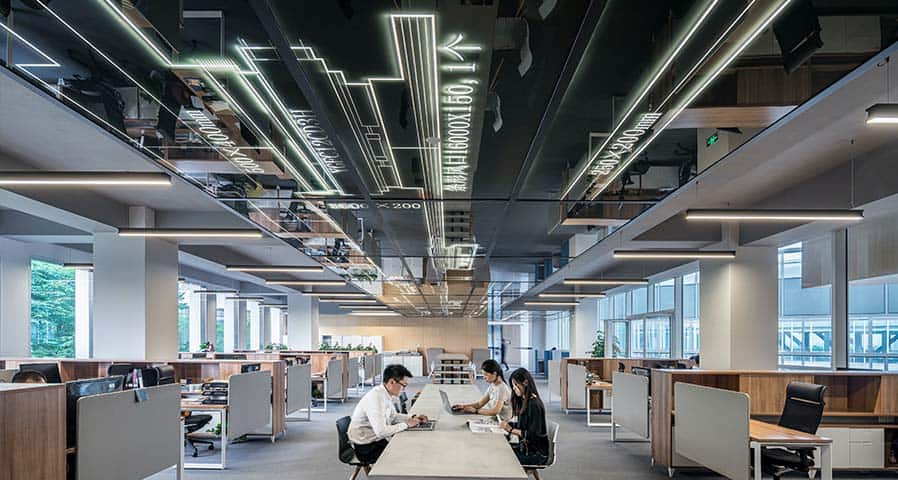One of the fastest-growing segments in smart buildings is lighting controls. On average, lighting controls can reduce energy usage by 24 to 28 percent.
Lighting controls are becoming standard in new buildings, but implementation is slow in existing facilities. Advancements in LED technology are starting to change this with controls that enhance energy savings and bring additional value. It’s something facility managers considering a next gen LED upgrade will want to think about as they plan their lighting retrofit.
Eight Smart Building Energy Efficiency Lighting Controls
Here’s a look at some of the common lighting controls found in most smart buildings.
1. Traditional Lighting Controls
These products include light switches and other standalone devices that control electrical loads and are connected to a centralized panel.
2. Room and Light-based Control Systems
These systems use sensors, integrated into the LED fixtures. The controls improve energy efficiency in smart buildings by automating the lights. Both systems, whether you are controlling the lighting in a room, or the building can be networked. It allows you to program the lights and even control them remotely via an app on a smartphone or tablet.
Did you know we have an in-depth lighting controls education center? We take a closer look at lighting controls, their separate categories, control types, and provide additional resources that include product comparisons, value engineering and so much more. Click here to explore our lighting controls education center.
3. Enterprise and Building-Based Control Systems
These lighting systems are networked across single or multiple buildings. Facility managers can program the lighting controls and receive usage data from the cloud or a central server. The system’s flexibility allows the application to meet the operator’s skill level.
An advantage of the system is the controllability of the LED lights. Instead of relying on expensive ballasts for dimming controls, it is a standard option on several types of LED lights. You can reduce energy usage without having to install expensive fixtures.
4. Embedded Smart Building Controls
Luminaires with embedded sensors are becoming more common. Not only do the controls improve energy efficiency in smart buildings, but it also simplifies installation.
5. Wireless Lighting Controls
Instead of using low-voltage wiring to enable communication between the lighting controls, many LED manufacturers use control points and radio waves. This type of lighting control is especially beneficial for existing structures. It makes the upgrade more cost-effective and does not disrupt facility operations during installation. Some wireless lighting controls are networkable, so you can receive data on everything from energy usage to information on the lighting’s operation.
6. Networked Lighting Controls
Networking lighting controls are becoming more common in smart buildings. The controls are assigned specific addresses for group or individual programming. You can operate the controls autonomously or integrate them into other systems. Some of the benefits associated with networked lighting controls include,
- detailed control zoning
- distributed intelligence
- zoning using software
- programmability
- data generation
Utilities and organizations are focusing on networked lighting controls as a way to reduce energy usage. The U.S. Department of Energy estimates that a third of all LED-based energy savings will be from connected lighting and controls by 2035.
7. Data Collection
Lighting systems connected to a wired or wireless network can collect and supply data on energy usage and monitor operations. Other integrated sensors in the LED bulbs can also monitor temperature and occupancy. There are also advanced lighting sensors that can collect data on carbon monoxide levels and even annual snowfalls.
The data is stored in the cloud or server and retrieved using the connected software.
8. Color-tuning Controls
LEDs are adjustable. You can adjust the lighting correlated color temperature (CCT) from warm to cool, depending on the task and preference. Facility managers can adjust the tunable lighting based on the time or day to match circadian rhythms. Color-tuning controls not only improve comfort in a space, but they can also boost productivity and occupants’ mental well-being. The list of how these controls can be used is almost endless.
Energy Efficiency in Smart Buildings with Action Services Group
You do not need a new structure to make it a smart building. Using LED technology, even older buildings can become energy efficient. Contact us today to learn about the products and services we offer and how you can reduce your buildings energy usage. Call 610-558-9773, emailing [email protected], or schedule a call that fits your needs by clicking the button below.







































0 Comments